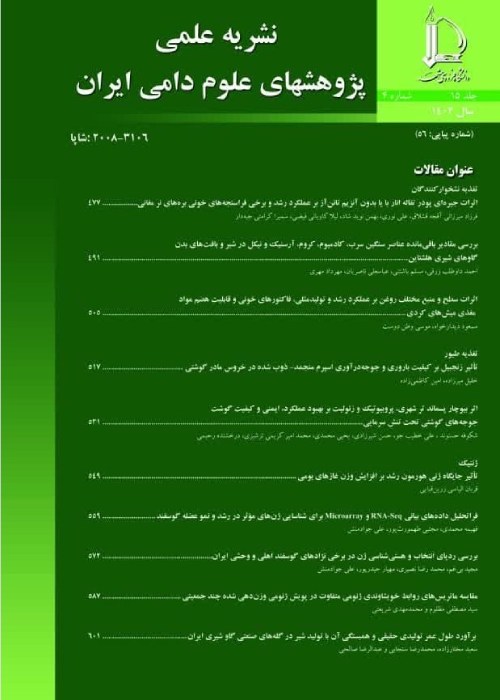Digestibility, chemical compound and protein quality of amaranthus forage at two harvested cut
Author(s):
Abstract:
Introduction Amaranth, genus Amaranthus, belongs to the Amaranthaceae family and includes more than 60 species (28). Amaranth forage, is distinguished by high yield performance of up to 70 t/ha (30). Plant maturity was found to affect neutral detergent fiber (NDF), acid detergent fiber (ADF), lignin, CP and nitrate content of amaranth forage (27). Several studies (21, 27, 29) have shown that the nutritive value of amaranth as a ruminant feed is equal to, or better than, commonly used forages such as alfalfa. Its favorable chemical analysis (e.g., high crude protein (CP) and low lignin ranges from 80 to 285 and from 17 to 73 g/kg DM, respectively) and its high dry matter (DM) digestibility (590790 g/kg DM) low nitrate and oxalic acid concentrations (below toxic levels) suggest that it has potential value as a ruminant feedstuff (21, 23, 27).
Materials and Methods The forage was planted in spring at one field (10 ha) near Karaj city (Iran). The area is at an altitude of 1215 m above sea level, with a mean annual rainfall and temperature is 305.8 mm and 15C◦, respectively. In the early autumn, samples were harvested by hand from at least 10 locations within the field and pooled to five samples. The dry samples were analyzed for DM (method 930.15), ash (method 924.05) and CP (method 9 84.13) of AOAC (6). Neutral detergent fibre (NDF) and acid detergent fibre (ADF) according to the method of Robertson and Van Soest (35) with NDF and ADF assayed sequentially without a heat stable amylase, and expressed inclusive of residual ash (25). Insoluble CP, soluble CP (SP), true protein (TP), AD insoluble CP (ADICP) and ND insoluble CP (NDICP) were determined according to Licitra method (15). Nitrate was determined by a colorimetric method (8), and oxalic acid was determined according to Abaza method (2). Ca and Mg were determined by atomic absorption, P was analyzed by spectrophotometer and K by flame emission spectrometer (6). DMD, OMD and DOMD were determined by a two stage technique for the in vitro digestion of forage crops (32). In a completely randomized experiment with factorial arrangement (2×2) the digestibility, chemical compound and protein quality of two varieties of amaranthus including: Kharkof (K), A. Spp.(S). which were planted as forage crops and harvested at two cuts, were studied. Data were subjected to analysis using the GLM procedure of SAS (26), using the statistical model: Yijk = µ Vi Dj Vi Dj eijk
Results and Discussion Results of in vitro two stage digestibility (IVD) for DM, OM and DOMD were 60.19, 58.16 and 49.09, respectively which were significantly (p>0.05) affected by cultivars and interaction between cultivars and cuts. Results indicated that the means of CP, ASH, NDF, ADF,ADL, NDIN, ADIN, Ca, P, Mg, and K were 14.72, 15.44, 40.85, 27.90,5.07,21.76,6.60, 1.55, 0.25, 0.28, 1.48, percent; respectively. Plant maturity was found to affect neutral detergent fiber (NDF), acid detergent fiber (ADF), lignin, CP and nitrate content of amaranth forage. Amaranth contains a high ash content due to its C4 metabolism and a very high carbon uptake per unit area (29). This high ash is in agreement with other researchers (1, 21) .Our amaranth accession had higher NDF (27) and lower ADF (22, 23) in comparison to A. Hypochondriacus reported by other researchers. Lignin content in amaranth is less than that reported by other researchers (27).
With increased plant maturity, fraction B1 decreased, probably due to an increase in cell wall bound N (16). Researchers observed that Similar results in CP fraction of amaranthus hypochoderyacus (21(. We observed that a negative relationship between NDF and fraction B1. There was a tendency for fraction B2 to increase with advancing maturity, similar to other researchers (21). At the second harvest, fraction B3 was higher than that at first harvest, similar to reserchers with amaranthus hypochondriacus (1). Different changes in NDF concentration of plant parts with maturity may explain the differences in proportions of fraction B3 (1). At the second harvest, fraction C increased due to increasing lignification (1). However, the content of fraction C was lower than that reported by abbasi et al. (1) and this fraction is unavailable to the animal (1).
Similar to our results, Sleugh et al. (27). Observed that as forages advance in maturity the CP content decreases (27). The total means of metabolizable energy obtained from IVD method was 2.56Mcal/kg DM. Our amaranth accession had lower metabolizable energy comparison to A. Hypochondriacus accession reported by other researchers (21). The different parts of protein including A, B1, B2, B3 and C, according to CNCPS system orderly were: 40.48, 2.24, 34.19, 16.09 and 7.01 percent of CP and NPN were 94.55 percent of soluble protein, the quantities of nitrate and oxalate were 0.34 and 5.37 percent (DM basis) respectively. Nitrate levels in our amaranthus forage were lower than the toxic level (i.e., >1030 g/kg DM) reported by some researchers (3, 35). Sleugh et al. (27)reported higher nitrate levels (i.e.,18g/kg DM) for A. Hypochondriacus (27). The oxalic acid content of our amaranth is lower than that observed by Several studies (i.e., 2114 g/kg DM) (5, 11, 31). Several studies have shown that the amount of amaranthus CP is between 12 to 27 Percent in whole crop (17, 29) and the other researchers show that the amount of amaranthus cp significantly decries by plant maturity 29). Some researchers reported that average of calcium, phosphorus and magnesium in the amaranths forage, is: 1.9, 0.26, and 0.6 respectively (1, 24).
Conclusion In general, results indicated that the Two varieties of Amaranthus tested in this study, potentially have considerable nutritive value as forage crops, meanwhile some of them have higher nutritive value.
Materials and Methods The forage was planted in spring at one field (10 ha) near Karaj city (Iran). The area is at an altitude of 1215 m above sea level, with a mean annual rainfall and temperature is 305.8 mm and 15C◦, respectively. In the early autumn, samples were harvested by hand from at least 10 locations within the field and pooled to five samples. The dry samples were analyzed for DM (method 930.15), ash (method 924.05) and CP (method 9 84.13) of AOAC (6). Neutral detergent fibre (NDF) and acid detergent fibre (ADF) according to the method of Robertson and Van Soest (35) with NDF and ADF assayed sequentially without a heat stable amylase, and expressed inclusive of residual ash (25). Insoluble CP, soluble CP (SP), true protein (TP), AD insoluble CP (ADICP) and ND insoluble CP (NDICP) were determined according to Licitra method (15). Nitrate was determined by a colorimetric method (8), and oxalic acid was determined according to Abaza method (2). Ca and Mg were determined by atomic absorption, P was analyzed by spectrophotometer and K by flame emission spectrometer (6). DMD, OMD and DOMD were determined by a two stage technique for the in vitro digestion of forage crops (32). In a completely randomized experiment with factorial arrangement (2×2) the digestibility, chemical compound and protein quality of two varieties of amaranthus including: Kharkof (K), A. Spp.(S). which were planted as forage crops and harvested at two cuts, were studied. Data were subjected to analysis using the GLM procedure of SAS (26), using the statistical model: Yijk = µ Vi Dj Vi Dj eijk
Results and Discussion Results of in vitro two stage digestibility (IVD) for DM, OM and DOMD were 60.19, 58.16 and 49.09, respectively which were significantly (p>0.05) affected by cultivars and interaction between cultivars and cuts. Results indicated that the means of CP, ASH, NDF, ADF,ADL, NDIN, ADIN, Ca, P, Mg, and K were 14.72, 15.44, 40.85, 27.90,5.07,21.76,6.60, 1.55, 0.25, 0.28, 1.48, percent; respectively. Plant maturity was found to affect neutral detergent fiber (NDF), acid detergent fiber (ADF), lignin, CP and nitrate content of amaranth forage. Amaranth contains a high ash content due to its C4 metabolism and a very high carbon uptake per unit area (29). This high ash is in agreement with other researchers (1, 21) .Our amaranth accession had higher NDF (27) and lower ADF (22, 23) in comparison to A. Hypochondriacus reported by other researchers. Lignin content in amaranth is less than that reported by other researchers (27).
With increased plant maturity, fraction B1 decreased, probably due to an increase in cell wall bound N (16). Researchers observed that Similar results in CP fraction of amaranthus hypochoderyacus (21(. We observed that a negative relationship between NDF and fraction B1. There was a tendency for fraction B2 to increase with advancing maturity, similar to other researchers (21). At the second harvest, fraction B3 was higher than that at first harvest, similar to reserchers with amaranthus hypochondriacus (1). Different changes in NDF concentration of plant parts with maturity may explain the differences in proportions of fraction B3 (1). At the second harvest, fraction C increased due to increasing lignification (1). However, the content of fraction C was lower than that reported by abbasi et al. (1) and this fraction is unavailable to the animal (1).
Similar to our results, Sleugh et al. (27). Observed that as forages advance in maturity the CP content decreases (27). The total means of metabolizable energy obtained from IVD method was 2.56Mcal/kg DM. Our amaranth accession had lower metabolizable energy comparison to A. Hypochondriacus accession reported by other researchers (21). The different parts of protein including A, B1, B2, B3 and C, according to CNCPS system orderly were: 40.48, 2.24, 34.19, 16.09 and 7.01 percent of CP and NPN were 94.55 percent of soluble protein, the quantities of nitrate and oxalate were 0.34 and 5.37 percent (DM basis) respectively. Nitrate levels in our amaranthus forage were lower than the toxic level (i.e., >1030 g/kg DM) reported by some researchers (3, 35). Sleugh et al. (27)reported higher nitrate levels (i.e.,18g/kg DM) for A. Hypochondriacus (27). The oxalic acid content of our amaranth is lower than that observed by Several studies (i.e., 2114 g/kg DM) (5, 11, 31). Several studies have shown that the amount of amaranthus CP is between 12 to 27 Percent in whole crop (17, 29) and the other researchers show that the amount of amaranthus cp significantly decries by plant maturity 29). Some researchers reported that average of calcium, phosphorus and magnesium in the amaranths forage, is: 1.9, 0.26, and 0.6 respectively (1, 24).
Conclusion In general, results indicated that the Two varieties of Amaranthus tested in this study, potentially have considerable nutritive value as forage crops, meanwhile some of them have higher nutritive value.
Keywords:
Language:
Persian
Published:
Iranian Journal of Animal Science Reaserch, Volume:7 Issue: 4, 2016
Pages:
428 to 436
magiran.com/p1518164
دانلود و مطالعه متن این مقاله با یکی از روشهای زیر امکان پذیر است:
اشتراک شخصی
با عضویت و پرداخت آنلاین حق اشتراک یکساله به مبلغ 1,390,000ريال میتوانید 70 عنوان مطلب دانلود کنید!
اشتراک سازمانی
به کتابخانه دانشگاه یا محل کار خود پیشنهاد کنید تا اشتراک سازمانی این پایگاه را برای دسترسی نامحدود همه کاربران به متن مطالب تهیه نمایند!
توجه!
- حق عضویت دریافتی صرف حمایت از نشریات عضو و نگهداری، تکمیل و توسعه مگیران میشود.
- پرداخت حق اشتراک و دانلود مقالات اجازه بازنشر آن در سایر رسانههای چاپی و دیجیتال را به کاربر نمیدهد.
In order to view content subscription is required
Personal subscription
Subscribe magiran.com for 70 € euros via PayPal and download 70 articles during a year.
Organization subscription
Please contact us to subscribe your university or library for unlimited access!



